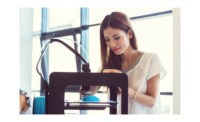Additive Quality
The greatest challenge of AM is the verification of parts’ absolute reliability.

Additive manufacturing continues to grow. The number of applications are on the rise, along with additive research. At this time last year, Paul Brackman was the only person working in the Zeiss Knoxville lab—today, he’s one of four full-time Zeiss staff at the lab, along with a team working in additive software applications at the Minneapolis headquarters, and a dedicated hardware team in Germany working on additive. It’s a large, global team and growing—which is a nice thing to be a part of, says Paul Brackman, additive manufacturing manager at ZEISS Industrial Quality Solutions
Additive is a priority at ZEISS, says Brackman. “We believe it is a really important thing for global manufacturing. We have invested a lot of resources into this lab, into the development work that’s going on in Germany and the U.S. It’s something we really believe in.”
Additive manufacturing, as opposed to older legacy technology, is a high risk, high reward area, Brackman notes. Additive processes don’t have the groundwork that’s behind other manufacturing processes, such as casting. In addition, the unique elements of additive—ones that enable exciting new parts—can make for some metrology challenges.
Working with additive parts affects the quality process in a number of ways. “Since it’s a relatively new way of manufacturing, a lot of things that we take for granted in the manufacturing process isn’t there,” Brackman says. “Not only the geometries, the raw material that you’re starting with and the actual construction of those geometries.”
“One of the nice things about additive is that you can branch out and go with new materials, develop your own boutique alloys,” he says, in order to develop materials with the specific properties you require.
With these new materials comes new possibilities—and potential issues. Measuring additively manufactured parts means throwing out the previous playbook in some inspection situations. In their research, they are trying to determine the effects of different characteristics of the raw materials. For example, the effect of porous powder on the percentages in the final part, along with particle size. For example, testing is being done to examine the effects of a tightly controlled raw material powder vs. a lower quality powder that wasn’t as tightly controlled. How does this affect the final product?
With so many variables, many different elements can change the material properties of the final part. In addition, Brackman explains that even after the printing has been finished, it’s important to consider the heat treatment involved.
“Heat treating is designed around the casting industry,” Brackman notes. “In an additive process, stresses on the parts are different, and heat treatment might not be the best for that part.” This may make the part certification process different as well.
“Every little step in the process is a rabbit hole that needs to be fully explored,” Brackman says.
With the emergence of additive manufacturing, medical applications such as structured implants have begun to adopt the technology.
“That’s a field that’s really exploded with the emergence of additive as a bona fide manufacturing technique,” Brackman says. In addition, in automotive, particularly electric vehicles, with the complex geometries of parts, it is possible to direct the stresses to an exact point on the part. For aerospace, printing blades is a good application for additive given the expense of testing new airfoil geometries, he notes. Being able to print internal cooling channels is another benefit of the additive process.
After the part is printed, the adventure continues. Then it’s time to examine the microstructure of the part and determine how small, targeted areas of the component have ended up. The benefit of having a “truly boutique part” is having the “exact material properties in the exact areas I want them,” Brackman says. This may involve looking at the structure through an X-ray microscope to see how the microstructure was formed, and how part geometry is affected.
Though the unique shapes are a big selling point of additive, Brackman says people may overlook the possibilities of the mechanical properties that additive allows.
“I think a lot of people when they first get started with additive are looking at shapes, struts, things that normally wouldn’t be possible with casting and machining, which is a big benefit of additive,” he says. “One of the more interesting things with additive is the ability to create unique mechanical properties.”
In other words, not only do the additive raw materials vary, the very same material can yield different results. Just by using different printing parameters on the same material, it’s possible to create different, mechanical properties, Brackman explains.
The research is ongoing. Through a ZEISS partnership with Oak Ridge National Laboratory, both organizations have invested in additive research. The ZEISS lab is within the Oak Ridge facility, near the main campus, and the organizations work together on the betterment of additive manufacturing and acceptance of the technology.
They have a five-year program and research agreement, which keeps the company focused, Brackman says. “While the end goal and finish line is still the same, the course of the race has definitely changed from what we expected.”
Looking for a reprint of this article?
From high-res PDFs to custom plaques, order your copy today!






